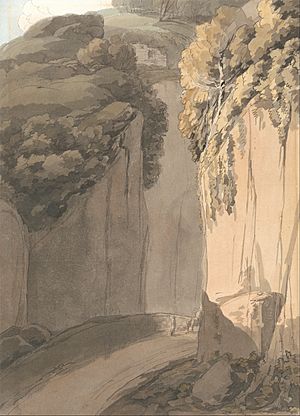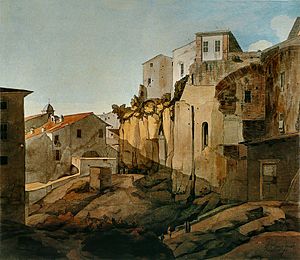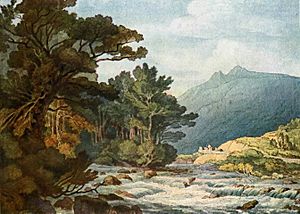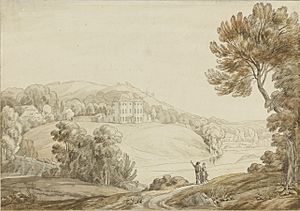Francis Towne facts for kids
Francis Towne (born 1739 or 1740 – died 7 July 1816) was a British artist. He was known for painting landscapes using watercolour. His paintings show places from the English Lake District to cities like Naples and Rome. For a long time, his work was not well-known. However, since the early 1900s, more and more people have started to appreciate his art.
Contents
Biography of Francis Towne
Francis Towne was born in Isleworth, a town in Middlesex, England. His father was a grain merchant. In 1752, Francis began training with Thomas Brookshead, a famous coach painter in London.
In 1759, he won an award for his designs from the Society of Arts. He also studied art for a while at St Martin’s Lane Academy. Later, one of his students, John White Abbott, said that Towne also studied with John Shackleton. Shackleton was an artist who painted portraits for the royal family.
Moving to Exeter and Early Art Career
In 1763, Towne worked for another coach painter named Thomas Watson. He went to Exeter for work and soon decided to live there. He had already started painting with oils and also taught drawing. In Exeter, he began to get painting jobs from rich families in Devon.
After a trip to north Wales in 1777, with his friend James White, Towne started to focus on painting with watercolours.
Travels to Italy and the Alps
In 1780, Towne traveled to Rome, Italy. There, he met and painted with John "Warwick" Smith and William Pars. Smith had been in Rome since 1776, and Pars was a friend from London.
In March 1781, Towne spent a month in Naples, staying with the artist Thomas Jones. After returning to Rome, he took trips to Tivoli and other nearby areas. He then traveled back to England with Smith, crossing the Alps mountains.
From this trip, Towne created over 200 paintings. This included 54 large views of Rome. These paintings mostly showed old ruins instead of newer buildings or daily life in the city. He showed these 54 paintings together in 1805, but he never sold them. Instead, when people asked for copies, he painted new ones. Many of these paintings were reworked later, starting around 1800. By then, Towne had adopted a bolder and more common painting style. When he died, Towne left these 54 paintings to the British Museum, where they are still kept today.
Later Life and Recognition
After returning to Devon, Sir Thomas and Lady Acland asked Towne to paint scenes in Devon and North Wales. In 1786, he went on a painting trip to the Lake District.
Towne also painted oil versions of his watercolours, including those from Rome. He mainly did this to show them to the Royal Academy. Although some of his works were shown, he tried 11 times to become a member of the Royal Academy but didn't succeed. He gave up trying in 1803.
He continued to paint and teach in Exeter and became quite successful. In his last years, he moved back to London. On August 5, 1807, he married Jeannette Hilligsberg, a 27-year-old French dancing teacher. Sadly, she passed away in April 1808.
Rediscovery of His Art
Francis Towne was not well-known until the early 1900s. Because of this, an art collector named Paul Oppé was able to buy many of Towne's important paintings for very little money. Oppé was very impressed, especially with Towne's elegant and unique early style. This style fit well with the art trends of the time.
Oppé later contacted the family members of Towne's student and friend, John Herman Merivale. He discovered a collection of paintings that Towne had left to Merivale in his will. These works had largely been unseen before. Oppé made a list of the paintings and wrote an article about Towne in a 1919 art journal. These writings helped to create new interest in Towne's art, and more of his works began to appear for sale.
By the 1950s, Francis Towne was widely recognized as an important artist. Many museums, especially the British Museum and the Yale Center for British Art, owned his works. A complete list of all his known artworks is published by the Paul Mellon Centre for Studies in British Art.
In January 2016, the British Museum held an exhibition of the watercolours Towne painted in Rome. Art critic Jonathan Jones wrote about it:
- Francis Towne tried 11 times to be elected to the Royal Academy but failed. However, he was smart enough to leave these watercolours to the British Museum when he died in 1816. He might not be a famous British artist, but as this amazing exhibition shows, he is a great one.
See also
 In Spanish: Francis Towne para niños
In Spanish: Francis Towne para niños





